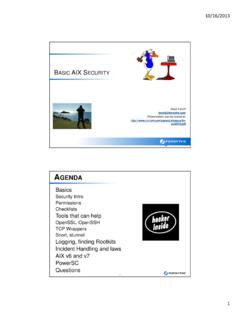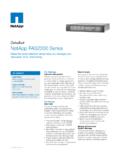Transcription of GPFS – INTRODUCTION AND S - Circle4.com
1 gpfs INTRODUCTION AND SETUP. Jaqui Lynch Handout at: Also: gpfs Forsythe Talks 2014 1. Agenda: gpfs Terminology gpfs INTRODUCTION Installing a 3 node cluster 2. gpfs : GENERAL PARALLEL FILE SYSTEM. Available since 1991 (AIX), on Linux since 2001. Product available on POWER and xSeries (IA32, IA64, Opteron) on AIX, Linux, Windows & BlueGene. Also runs on compatible non-IBM servers and storage. Thousands of installs, including many Top 500 supercomputers Concurrent shared disk access to a single global namespace. Customers use gpfs in many applications High-performance computing Scalable file and Web servers Database and digital libraries Digital media Oracle data Analytics, financial data management, engineering design, . 3. What is Parallel I/O? A cluster of machines access shared storage with single file system name space with POSIX semantics.
2 Caching and striping across all disks with distributed locking The robust system design can recover from node failure using metadata logging. The solution scales to thousands of nodes with a variety of I/O. gpfs File Syst e m Nodes Sw it ching fa bric Sha red disks Diagram courtesy of IBM. 4. gpfs TERMINOLOGY 1/2. Cluster - This consists of a number of nodes and network shared disks (NSDs) for management purposes. Storage Pool - This groups a file system's storage and allows a user to partition storage based on characteristics such as performance, locality and reliability. Node - This is an individual OS instance within a cluster. Nodeset - This is a group of nodes that are all running the same level of gpfs and working on the same file systems. A cluster can contain more than one nodeset, but a node can only belong to one nodeset.
3 A nodeset can contain up to 32 file systems. Configuration manager - This has overall responsibility for correct operation of all the nodes and the cluster as a whole. It selects the file-system manager node for each file- system, determines succession if a file-system manager node fails and also monitors quorum. By default, quorum is set to 50% +1. File-system manager - Also referred to as the "stripe group manager," there can be only one at a time. This node maintains the availability information for the disks in the file system. In a large cluster, this may need to be a dedicated node that's separate from the disk servers. 5. gpfs TERMINOLOGY 2/2. Stripe group - This is basically a collection of disks a file system gets mounted on. Token manager - This handles tokens for the file handles and synchronizes concurrent access to files, ensuring consistency among caches.
4 The token-manager server also synchronizes certain pieces of gpfs metadata and some of the internal data structures. The token-manager server usually resides on the file-system manager and may need significant CPU power. Metanode - A node that handles metadata, also referred to as "directory block updates.". Application node - This mounts a gpfs file system and runs a user application that accesses the file system. Network shared disk (NSD) - This component is used for global device naming and data access in a cluster. NSDs are created on local disk drives. The NSD component performs automatic discovery at each node to see if any physical disks are attached. If there are no disks, an NSD must be defined with a primary server. Best practices dictate that a secondary server should also be defined.
5 I/O is then performed using the network connection to get to the NSD server that performs the I/O on behalf of the requesting node. NSDs can also be used to provide backup in case a physical connection to disk fails. 6. gpfs FUNCTIONS AND FEATURES. FUNCTIONS FEATURES. Performance Quorum management Scaling to thousands of nodes High availability with independent paths Petabytes of storage supported Striping using blocks (supports sub- Parallel data and metadata from server blocks). nodes and disks Byte/block range locking (rather than file High Availability + Disaster Recovery or extent locking). Multi-platform + Interoperability: Linux, gpfs pagepool AIX and NFS/CIFS support Access pattern optimization Multi-cluster/WAN AFM function Distributed management ( metadata +. Online system management tokens).
6 Cache management, Quotas, File system journaling with POSIX. Snapshots semantics Information Lifecycle Management Quotas API, Performance tuning Integrated Life Management: pools, Fault tolerance & Disaster recovery filesets, policies Multi-cluster support Data replication, snapshots, clones 7. gpfs SCALING CAPABILITIES - TESTED. Linux on x86 Nodes: 9300. AIX Nodes: 1530. Windows on x86 Nodes: 64. Linux on x86 & AIX combo: 3906 3794 Linux & 112 AIX. Contact if you intend to exceed: Configurations with Linux nodes exceeding 512 nodes Configurations with AIX nodes exceeding 128 nodes Configurations with Windows nodes exceeding 64 nodes FPO-enabled configurations exceeding 64 nodes Filesystem Size: 2PB+ (299 bytes) if > gpfs Number of mounted filesystems in a cluster is 256. Number of files in a filesystem if created by or later 2,147,483,648.
7 For gpfs architectural limit is 264 and tested is 9,000,000,000. For additional scaling limits check the FAQ at: aqs% 8. gpfs SCALING CAPABILITIES - SEEN. Nodes: 2000+ (8K). LUNS: 2000+. Filesystem Size: 2PB+ (299 bytes). Mounted filesystems: 256. Lun size: > 2TB (64bit). Number of Files in FS: 1 Billion+ - 264 files per filesystem Maximum file size equals file system size Production file systems 4PB. Tiered storage: solid state drives, SATA/SAS drives, tape Disk I/O to AIX @ 134 GB/sec Disk I/O to Linux @ 66 GB/sec 9. File Data Infrastructure Optimization Databases Connections IBM gpfs is designed to SAN. enable: TCP/IP. InfiniBand A single global namespace File Servers across platforms. Management High performance common Centralized storage. monitoring &. automated file Eliminating copies of data.
8 Mgmt Backup /. Improved storage use. Archive Availability Simplified file management. Data migration, replication, backup Application Servers Slide courtesy of IBM. 2012 IBM Corporat ion 10. BASIC gpfs CLUSTER WITH SHARED SAN. Each node has direct speeds gpfs . Can be dedicated SAN, St orage area vSCSI, NPIV. net work (SAN). Simultaneous LUN access All features are included. All software features: snapshots, replication and multisite connectivity are included in the gpfs license. With no license keys except for client and server to add on, you get all of the features up front. Slide courtesy of IBM. 2012 IBM Corporat ion 11. NETWORK-BASED BLOCK I/O. Application data access on network Network shared attached nodes is exactly the same as Local area network (LAN). disk (NSD) clients a storage area network (SAN).
9 Attached node. General Parallel File System ( gpfs ) transparently sends the block-level I/O request over a NSD servers /. TCP/IP network. High IO apps Any node can add direct attach for SAN SAN. greater throughput. Why? Enable virtually seamless multi-site operations Reduce costs for data administration Provide flexibility of file system access Establish highly scalable and reliable data storage Future protection by supporting mixed technologies Slide courtesy of IBM 12. 2012 IBM Corporat ion OPERATING SYSTEMS AND SOFTWARE. Servers: IBM AIX. gpfs cannot run in a WPAR but can be shared with a WPAR as a named FS. Linux RHEL. SLES. VMWARE ESX Server Windows 2008 Server Some examples of Software: IBM DB2. Oracle SAP. SAS. Ab Initio Informatica SAF. 13. Supported Environments gpfs Version AIX Y Y N.
10 AIX Y Y Y. AIX Y Y Y. Linux on Power RHEL4,5,6 RHEL4,5,6 RHEL5,6. SLES9,10,11 SLES10,11 SLES10,11. Linux on x86 RHEL4,5,6 RHEL4,5,6 RHEL5,6. SLES9,10,11 SLES10,11 SLES10,11. Windows Server 2008 x64 (SP2) Y Y Y. Windows Server 2008 R2 x64 Y Y Y. Check the FAQ for details on OS level, kernel levels, patches, etc gpfs went EOS on September 30, 2011. gpfs goes EOM on April 17, 2012. 2012 IBM Corporat ion 14. LICENSING. gpfs Server license (performs mgmt functions or exports data). gpfs management roles: quorum node, file system manager, cluster configuration manager, NSD server Exports data through applications such as NFS, CIFS, FTP or HTTP. Data access local or via network The gpfs cluster requires, at minimum, one gpfs Server licensed node (LPAR). Two server licensed nodes provide minimum high- availability.




